Tom Kepler's Blog, page 3
January 11, 2022
A Flash Fiction Experience
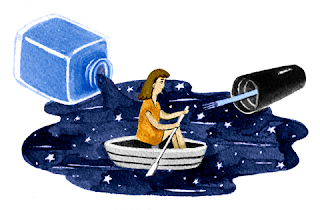 This has been an interesting winter, what with a front tooth extraction (tooth #9). The experience literally put me off my feed, and it also motivated me to give myself a break and to take it easy for a while. Funny things can happen, though, when stepping back for a little rest--good-funny things. Writing a flash fiction story recently was one for me.
This has been an interesting winter, what with a front tooth extraction (tooth #9). The experience literally put me off my feed, and it also motivated me to give myself a break and to take it easy for a while. Funny things can happen, though, when stepping back for a little rest--good-funny things. Writing a flash fiction story recently was one for me.I woke up at dawn, which is not unusual for me, but I had this scenario in my head, this story, this moment when reality shifts. And so I got up, sat down with my laptop, and wrote out the mind event--680 some words. The storyline is about an elderly couple checking out a new "antique shop," aka junk store, for some new finds. The theme, though, is about reawakening and rejuvenation. Set in spring, my subconscious must have already been looking past this winter while I slept. I'll take the gift.
I revised the story about four times over a month, working with my comfortable routine of writing and then letting the work sit for a time before coming back to it. One thing I like about flash fiction is the quick return on my effort. The satisfaction of saying, "Yes, it's done!" doesn't have to be put off for a year or two. That's a good feeling.
I've submitted the flash fiction story to the online literary website Every Day Fiction. Theme submissions seem to be my flash fiction forte (alliteration!) for this website. My previous publishing here was a Halloween story called "Spider." My submitted story, "Out with the Old," is submitted for the March theme of springtime.
Until March arrives (and if the story is accepted), feel free to read "Spider." I had wanted for years to write a creepy story, so writing a Halloween story was a fun exercise. Another flash fiction story, published on New Year's Day in 2011 at 365 Tomorrows is "In the Beginning," a science fiction story. I do seem to flash on specialty themes. This sci fi story is a twist on the Adam and Eve narrative.
Now for me it's on to writing more on my science fiction story that I've been posting on Amazon's Vella, titled at this point Grav Board. I started this novel during an emotionally challenging time, just sitting down at the keyboard and letting myself slip off into another universe, exploring another planet. Great fun! I've taken about six weeks off from this story, so now it's time to get back! Cheers!
 #mc_embed_signup{background:#fff; clear:left; font:14px Helvetica,Arial,sans-serif; } /* Add your own Mailchimp form style overrides in your site stylesheet or in this style block. We recommend moving this block and the preceding CSS link to the HEAD of your HTML file. */ Follow by Email* indicates required Email Address * First Name Last Name (function($) {window.fnames = new Array(); window.ftypes = new Array();fnames[0]='EMAIL';ftypes[0]='email';fnames[1]='FNAME';ftypes[1]='text';fnames[2]='LNAME';ftypes[2]='text';fnames[3]='ADDRESS';ftypes[3]='address';fnames[4]='PHONE';ftypes[4]='phone';}(jQuery));var $mcj = jQuery.noConflict(true);
#mc_embed_signup{background:#fff; clear:left; font:14px Helvetica,Arial,sans-serif; } /* Add your own Mailchimp form style overrides in your site stylesheet or in this style block. We recommend moving this block and the preceding CSS link to the HEAD of your HTML file. */ Follow by Email* indicates required Email Address * First Name Last Name (function($) {window.fnames = new Array(); window.ftypes = new Array();fnames[0]='EMAIL';ftypes[0]='email';fnames[1]='FNAME';ftypes[1]='text';fnames[2]='LNAME';ftypes[2]='text';fnames[3]='ADDRESS';ftypes[3]='address';fnames[4]='PHONE';ftypes[4]='phone';}(jQuery));var $mcj = jQuery.noConflict(true);
November 19, 2021
Six Books on Our Relationship with Nature
 Recently I've been interested in reading about the relationship we can develop with nature--or should I write that with a capital, Nature? What I've discovered is that most of the books I've run across that I want to read are not at my local public library because they are not heavy hitters in terms of sales. Kindle has become the go-to purchase choice for me, and it's pretty convenient, I must say. Here are some of the books I've purchased that I've either read or are on my winter reading list. As you'll see, they represent a broad perspective of how people, and specifically how I, can interact with the natural world. Wilding: Returning Nature to Our Farm
Recently I've been interested in reading about the relationship we can develop with nature--or should I write that with a capital, Nature? What I've discovered is that most of the books I've run across that I want to read are not at my local public library because they are not heavy hitters in terms of sales. Kindle has become the go-to purchase choice for me, and it's pretty convenient, I must say. Here are some of the books I've purchased that I've either read or are on my winter reading list. As you'll see, they represent a broad perspective of how people, and specifically how I, can interact with the natural world. Wilding: Returning Nature to Our Farm
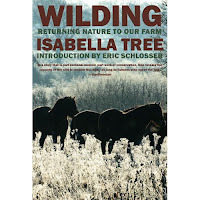 Author, Isabella Tree. I was surprised to discover that this book is heavily researched and documented, so a lot of background information is provided and also support for the concept of allowing nature to coordinate how a piece of land is "managed" for best ecological results. It really is an eye-opener and also provided me with hope. On Knepp Castle Estate, an ancient, English estate, Isabella Tree and her husband (the inheritor) decide to "re-wild" the land. Their ecological, social, and legal journey includes the return of weeds and trash brush, the introduction of wild cattle and hogs, and the return of many birds that are in danger of extinction in Britain. It's a fascinating read.
Author, Isabella Tree. I was surprised to discover that this book is heavily researched and documented, so a lot of background information is provided and also support for the concept of allowing nature to coordinate how a piece of land is "managed" for best ecological results. It really is an eye-opener and also provided me with hope. On Knepp Castle Estate, an ancient, English estate, Isabella Tree and her husband (the inheritor) decide to "re-wild" the land. Their ecological, social, and legal journey includes the return of weeds and trash brush, the introduction of wild cattle and hogs, and the return of many birds that are in danger of extinction in Britain. It's a fascinating read.Of the books I've purchased, Wilding is the only one I've completely read so far. The others I'm reading a bit at a time. In fact, the next four I'm reading concurrently, as my mood dictates. I'll read a bit in one and then another.
One Unbounded Ocean of Consciousness: Simple Answers to the Big Questions in Life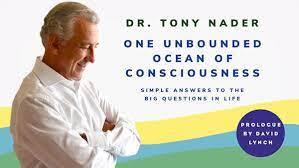 Author, Tony Nader. Dr. Nader is the head of the organization that teaches the Transcendental Meditation technique. He was taught and appointed by Maharishi Mahesh Yogi, who introduced the meditation technique and the Vedic understanding of the nature and range of consciousness to the Western world over sixty years ago. Because Dr. Nader is a medical doctor and researcher, he provides a comprehensive look at the relationship of consciousness, reality, the world, and ourselves. He connects Vedic wisdom and the historical and most current scientific understanding of what existence is and how human consciousness interacts with reality. His basic premise is that everything is consciousness, and his development of this concept from both Vedic and scientific perspectives is comprehensive. One of the most interesting results of reading this book is the discovery that our everyday understanding of our relationship with the world is quite limited (and probably outdated); even science has a much more expanded and "cosmic" perspective of how we perceive the world. House of Rain: Tracking a Vanished Civilization Across the American Southwest
Author, Tony Nader. Dr. Nader is the head of the organization that teaches the Transcendental Meditation technique. He was taught and appointed by Maharishi Mahesh Yogi, who introduced the meditation technique and the Vedic understanding of the nature and range of consciousness to the Western world over sixty years ago. Because Dr. Nader is a medical doctor and researcher, he provides a comprehensive look at the relationship of consciousness, reality, the world, and ourselves. He connects Vedic wisdom and the historical and most current scientific understanding of what existence is and how human consciousness interacts with reality. His basic premise is that everything is consciousness, and his development of this concept from both Vedic and scientific perspectives is comprehensive. One of the most interesting results of reading this book is the discovery that our everyday understanding of our relationship with the world is quite limited (and probably outdated); even science has a much more expanded and "cosmic" perspective of how we perceive the world. House of Rain: Tracking a Vanished Civilization Across the American Southwest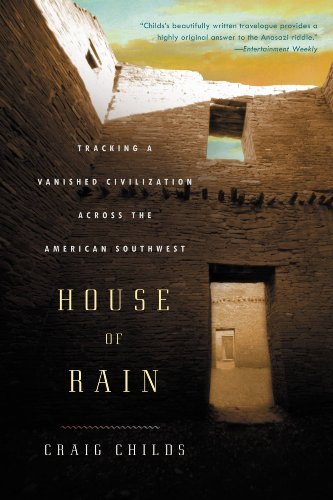 Author, Craig Childs. One of my personal goals is to make the journey to the American Southwest with my Airstream Basecamp trailer and spend time exploring the ancient cultures of the Anasazi. And, by the way, this book House of Rain has informed me that the word Anasazi is not the preferred term any longer; meaning "ancient enemy" in Navajo, the indigenous peoples of the Southwest preferably to not choose to refer to their ancestors as enemies. “Ancestral Pueblo” or “Ancestral Puebloan" are preferred terms. This book combines the author's personal experiences with his explorations of the ruins and his research of these ancient cultures. What has touched me most so far in my reading is how the construction of the cliff dwellings was so intimately connected to nature--the seasons and the path of the sun, the topography of the land and the situating of the buildings. There is an alignment with nature. This is something that is certainly not common in modern building and community planning.
Author, Craig Childs. One of my personal goals is to make the journey to the American Southwest with my Airstream Basecamp trailer and spend time exploring the ancient cultures of the Anasazi. And, by the way, this book House of Rain has informed me that the word Anasazi is not the preferred term any longer; meaning "ancient enemy" in Navajo, the indigenous peoples of the Southwest preferably to not choose to refer to their ancestors as enemies. “Ancestral Pueblo” or “Ancestral Puebloan" are preferred terms. This book combines the author's personal experiences with his explorations of the ruins and his research of these ancient cultures. What has touched me most so far in my reading is how the construction of the cliff dwellings was so intimately connected to nature--the seasons and the path of the sun, the topography of the land and the situating of the buildings. There is an alignment with nature. This is something that is certainly not common in modern building and community planning.
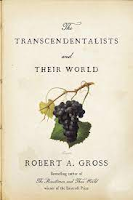 Author, Robert A. Gross. Forty years ago, Robert Gross published The Minutemen and Their World, an academic study of the Minutemen of Concord, Massachusetts, and their community. It's been reissued, and Gross has also published now a look at the Transcendentalists and how they lived and interacted in their community at Concord. I've started reading this and am excited to discover how such a profound and individual vision of personal freedom and spirituality as Transcendentalism bubbled up at Concord. From what I've read so far, the citizens of Concord, for instance, looked at our dear Henry David Thoreau with a mixture of pride, awe, and quite a bit of puzzled head-scratching. I'm looking forward to a more complete understanding of the cultural milieu that produced this world perspective.
Author, Robert A. Gross. Forty years ago, Robert Gross published The Minutemen and Their World, an academic study of the Minutemen of Concord, Massachusetts, and their community. It's been reissued, and Gross has also published now a look at the Transcendentalists and how they lived and interacted in their community at Concord. I've started reading this and am excited to discover how such a profound and individual vision of personal freedom and spirituality as Transcendentalism bubbled up at Concord. From what I've read so far, the citizens of Concord, for instance, looked at our dear Henry David Thoreau with a mixture of pride, awe, and quite a bit of puzzled head-scratching. I'm looking forward to a more complete understanding of the cultural milieu that produced this world perspective.
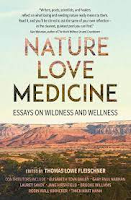 Editor, Thomas Lowe Fleischner. This book of essays focuses on the theme that if we find a way to integrate with nature, then we become more integrated, healthy, dynamic individuals and communities. From what I've read so far, the essays include a mixture of personal experience and scientific and medical understanding of the benefits of getting outside and developing a connection with the natural world. Not only are the effects on individuals in nature explored but also how communities benefit when local governments consciously include green zones and such in city planning. One essay I read included medical and crime statistics. Because this book includes a collection of authors, it provides multiple perspectives of why we should get out in nature as a regular part of our daily routines. According to my Kindle app, I've only read 13% of this anthology, so I've got some good reading and reflecting ahead for this winter season.Feral: Rewilding the Land, the Sea, and Human Life
Editor, Thomas Lowe Fleischner. This book of essays focuses on the theme that if we find a way to integrate with nature, then we become more integrated, healthy, dynamic individuals and communities. From what I've read so far, the essays include a mixture of personal experience and scientific and medical understanding of the benefits of getting outside and developing a connection with the natural world. Not only are the effects on individuals in nature explored but also how communities benefit when local governments consciously include green zones and such in city planning. One essay I read included medical and crime statistics. Because this book includes a collection of authors, it provides multiple perspectives of why we should get out in nature as a regular part of our daily routines. According to my Kindle app, I've only read 13% of this anthology, so I've got some good reading and reflecting ahead for this winter season.Feral: Rewilding the Land, the Sea, and Human Life 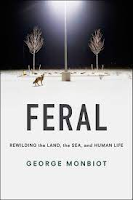 Author, George Monbiot. I've only read three percent of this book so far, but I'm looking forward to engaging with the content. Monbiot is an environmentalist who has written quite a few books about how humankind are devastating our planet. This book provides an optimistic note that the natural world can regenerate if provided a fair chance by humanity. The book blurb explains: "An optimistic approach to environmentalism that focuses on the wonders of rewilding, not just the terrifying consequences of climate change." The author shares with us a vision of "how, by inviting nature back into our lives, we can simultaneously cure our 'ecological boredom' and begin repairing centuries of environmental damage. Monbiot takes readers on an enchanting journey around the world to explore ecosystems that have been 'rewilded': freed from human intervention and allowed—in some cases for the first time in millennia—to resume their natural ecological processes." I'm looking forward to reading this book.
Author, George Monbiot. I've only read three percent of this book so far, but I'm looking forward to engaging with the content. Monbiot is an environmentalist who has written quite a few books about how humankind are devastating our planet. This book provides an optimistic note that the natural world can regenerate if provided a fair chance by humanity. The book blurb explains: "An optimistic approach to environmentalism that focuses on the wonders of rewilding, not just the terrifying consequences of climate change." The author shares with us a vision of "how, by inviting nature back into our lives, we can simultaneously cure our 'ecological boredom' and begin repairing centuries of environmental damage. Monbiot takes readers on an enchanting journey around the world to explore ecosystems that have been 'rewilded': freed from human intervention and allowed—in some cases for the first time in millennia—to resume their natural ecological processes." I'm looking forward to reading this book.
 #mc_embed_signup{background:#fff; clear:left; font:14px Helvetica,Arial,sans-serif; } /* Add your own Mailchimp form style overrides in your site stylesheet or in this style block. We recommend moving this block and the preceding CSS link to the HEAD of your HTML file. */ Follow by Email* indicates required Email Address * First Name Last Name (function($) {window.fnames = new Array(); window.ftypes = new Array();fnames[0]='EMAIL';ftypes[0]='email';fnames[1]='FNAME';ftypes[1]='text';fnames[2]='LNAME';ftypes[2]='text';fnames[3]='ADDRESS';ftypes[3]='address';fnames[4]='PHONE';ftypes[4]='phone';}(jQuery));var $mcj = jQuery.noConflict(true);
#mc_embed_signup{background:#fff; clear:left; font:14px Helvetica,Arial,sans-serif; } /* Add your own Mailchimp form style overrides in your site stylesheet or in this style block. We recommend moving this block and the preceding CSS link to the HEAD of your HTML file. */ Follow by Email* indicates required Email Address * First Name Last Name (function($) {window.fnames = new Array(); window.ftypes = new Array();fnames[0]='EMAIL';ftypes[0]='email';fnames[1]='FNAME';ftypes[1]='text';fnames[2]='LNAME';ftypes[2]='text';fnames[3]='ADDRESS';ftypes[3]='address';fnames[4]='PHONE';ftypes[4]='phone';}(jQuery));var $mcj = jQuery.noConflict(true);
Five Books on Our Relationship with Nature
 Recently I've been interested in reading about the relationship we can develop with nature--or should I write that with a capital, Nature? What I've discovered is that most of the books I've run across that I want to read are not at my local public library because they are not heavy hitters in terms of sales. Kindle has become the go-to purchase choice for me, and it's pretty convenient, I must say. Here are some of the books I've purchased that I've either read or are on my winter reading list. As you'll see, they represent a broad perspective of how people, and specifically how I, can interact with the natural world. Wilding: Returning Nature to Our Farm
Recently I've been interested in reading about the relationship we can develop with nature--or should I write that with a capital, Nature? What I've discovered is that most of the books I've run across that I want to read are not at my local public library because they are not heavy hitters in terms of sales. Kindle has become the go-to purchase choice for me, and it's pretty convenient, I must say. Here are some of the books I've purchased that I've either read or are on my winter reading list. As you'll see, they represent a broad perspective of how people, and specifically how I, can interact with the natural world. Wilding: Returning Nature to Our Farm
 Author, Isabella Tree. I was surprised to discover that this book is heavily researched and documented, so a lot of background information is provided and also support for the concept of allowing nature to coordinate how a piece of land is "managed" for best ecological results. It really is an eye-opener and also provided me with hope. On Knepp Castle Estate, an ancient, English estate, Isabella Tree and her husband (the inheritor) decide to "re-wild" the land. Their ecological, social, and legal journey includes the return of weeds and trash brush, the introduction of wild cattle and hogs, and the return of many birds that are in danger of extinction in Britain. It's a fascinating read.
Author, Isabella Tree. I was surprised to discover that this book is heavily researched and documented, so a lot of background information is provided and also support for the concept of allowing nature to coordinate how a piece of land is "managed" for best ecological results. It really is an eye-opener and also provided me with hope. On Knepp Castle Estate, an ancient, English estate, Isabella Tree and her husband (the inheritor) decide to "re-wild" the land. Their ecological, social, and legal journey includes the return of weeds and trash brush, the introduction of wild cattle and hogs, and the return of many birds that are in danger of extinction in Britain. It's a fascinating read.Of the books I've purchased, Wilding is the only one I've completely read so far. The others I'm reading a bit at a time. In fact, the next four I'm reading concurrently, as my mood dictates. I'll read a bit in one and then another.
One Unbounded Ocean of Consciousness: Simple Answers to the Big Questions in Life Author, Tony Nader. Dr. Nader is the head of the organization that teaches the Transcendental Meditation technique. He was taught and appointed by Maharishi Mahesh Yogi, who introduced the meditation technique and the Vedic understanding of the nature and range of consciousness to the Western world over sixty years ago. Because Dr. Nader is a medical doctor and researcher, he provides a comprehensive look at the relationship of consciousness, reality, the world, and ourselves. He connects Vedic wisdom and the historical and most current scientific understanding of what existence is and how human consciousness interacts with reality. His basic premise is that everything is consciousness, and his development of this concept from both Vedic and scientific perspectives is comprehensive. One of the most interesting results of reading this book is the discovery that our everyday understanding of our relationship with the world is quite limited (and probably outdated); even science has a much more expanded and "cosmic" perspective of how we perceive the world. House of Rain: Tracking a Vanished Civilization Across the American Southwest
Author, Tony Nader. Dr. Nader is the head of the organization that teaches the Transcendental Meditation technique. He was taught and appointed by Maharishi Mahesh Yogi, who introduced the meditation technique and the Vedic understanding of the nature and range of consciousness to the Western world over sixty years ago. Because Dr. Nader is a medical doctor and researcher, he provides a comprehensive look at the relationship of consciousness, reality, the world, and ourselves. He connects Vedic wisdom and the historical and most current scientific understanding of what existence is and how human consciousness interacts with reality. His basic premise is that everything is consciousness, and his development of this concept from both Vedic and scientific perspectives is comprehensive. One of the most interesting results of reading this book is the discovery that our everyday understanding of our relationship with the world is quite limited (and probably outdated); even science has a much more expanded and "cosmic" perspective of how we perceive the world. House of Rain: Tracking a Vanished Civilization Across the American Southwest Author, Craig Childs. One of my personal goals is to make the journey to the American Southwest with my Airstream Basecamp trailer and spend time exploring the ancient cultures of the Anasazi. And, by the way, this book House of Rain has informed me that the word Anasazi is not the preferred term any longer; meaning "ancient enemy" in Navajo, the indigenous peoples of the Southwest preferably to not choose to refer to their ancestors as enemies. “Ancestral Pueblo” or “Ancestral Puebloan" are preferred terms. This book combines the author's personal experiences with his explorations of the ruins and his research of these ancient cultures. What has touched me most so far in my reading is how the construction of the cliff dwellings was so intimately connected to nature--the seasons and the path of the sun, the topography of the land and the situating of the buildings. There is an alignment with nature. This is something that is certainly not common in modern building and community planning.
Author, Craig Childs. One of my personal goals is to make the journey to the American Southwest with my Airstream Basecamp trailer and spend time exploring the ancient cultures of the Anasazi. And, by the way, this book House of Rain has informed me that the word Anasazi is not the preferred term any longer; meaning "ancient enemy" in Navajo, the indigenous peoples of the Southwest preferably to not choose to refer to their ancestors as enemies. “Ancestral Pueblo” or “Ancestral Puebloan" are preferred terms. This book combines the author's personal experiences with his explorations of the ruins and his research of these ancient cultures. What has touched me most so far in my reading is how the construction of the cliff dwellings was so intimately connected to nature--the seasons and the path of the sun, the topography of the land and the situating of the buildings. There is an alignment with nature. This is something that is certainly not common in modern building and community planning.
 Author, Robert A. Gross. Forty years ago, Robert Gross published The Minutemen and Their World, an academic study of the Minutemen of Concord, Massachusetts, and their community. It's been reissued, and Gross has also published now a look at the Transcendentalists and how they lived and interacted in their community at Concord. I've started reading this and am excited to discover how such a profound and individual vision of personal freedom and spirituality as Transcendentalism bubbled up at Concord. From what I've read so far, the citizens of Concord, for instance, looked at our dear Henry David Thoreau with a mixture of pride, awe, and quite a bit of puzzled head-scratching. I'm looking forward to a more complete understanding of the cultural milieu that produced this world perspective.
Author, Robert A. Gross. Forty years ago, Robert Gross published The Minutemen and Their World, an academic study of the Minutemen of Concord, Massachusetts, and their community. It's been reissued, and Gross has also published now a look at the Transcendentalists and how they lived and interacted in their community at Concord. I've started reading this and am excited to discover how such a profound and individual vision of personal freedom and spirituality as Transcendentalism bubbled up at Concord. From what I've read so far, the citizens of Concord, for instance, looked at our dear Henry David Thoreau with a mixture of pride, awe, and quite a bit of puzzled head-scratching. I'm looking forward to a more complete understanding of the cultural milieu that produced this world perspective.
 Editor, Thomas Lowe Fleischner. This book of essays focuses on the theme that if we find a way to integrate with nature, then we become more integrated, healthy, dynamic individuals and communities. From what I've read so far, the essays include a mixture of personal experience and scientific and medical understanding of the benefits of getting outside and developing a connection with the natural world. Not only are the effects on individuals in nature explored but also how communities benefit when local governments consciously include green zones and such in city planning. One essay I read included medical and crime statistics. Because this book includes a collection of authors, it provides multiple perspectives of why we should get out in nature as a regular part of our daily routines. According to my Kindle app, I've only read 13% of this anthology, so I've got some good reading and reflecting ahead for this winter season.Feral: Rewilding the Land, the Sea, and Human Life
Editor, Thomas Lowe Fleischner. This book of essays focuses on the theme that if we find a way to integrate with nature, then we become more integrated, healthy, dynamic individuals and communities. From what I've read so far, the essays include a mixture of personal experience and scientific and medical understanding of the benefits of getting outside and developing a connection with the natural world. Not only are the effects on individuals in nature explored but also how communities benefit when local governments consciously include green zones and such in city planning. One essay I read included medical and crime statistics. Because this book includes a collection of authors, it provides multiple perspectives of why we should get out in nature as a regular part of our daily routines. According to my Kindle app, I've only read 13% of this anthology, so I've got some good reading and reflecting ahead for this winter season.Feral: Rewilding the Land, the Sea, and Human Life  Author, George Monbiot. I've only read three percent of this book so far, but I'm looking forward to engaging with the content. Monbiot is an environmentalist who has written quite a few books about how humankind are devastating our planet. This book provides an optimistic note that the natural world can regenerate if provided a fair chance by humanity. The book blurb explains: "An optimistic approach to environmentalism that focuses on the wonders of rewilding, not just the terrifying consequences of climate change." The author shares with us a vision of "how, by inviting nature back into our lives, we can simultaneously cure our 'ecological boredom' and begin repairing centuries of environmental damage. Monbiot takes readers on an enchanting journey around the world to explore ecosystems that have been 'rewilded': freed from human intervention and allowed—in some cases for the first time in millennia—to resume their natural ecological processes." I'm looking forward to reading this book.
Author, George Monbiot. I've only read three percent of this book so far, but I'm looking forward to engaging with the content. Monbiot is an environmentalist who has written quite a few books about how humankind are devastating our planet. This book provides an optimistic note that the natural world can regenerate if provided a fair chance by humanity. The book blurb explains: "An optimistic approach to environmentalism that focuses on the wonders of rewilding, not just the terrifying consequences of climate change." The author shares with us a vision of "how, by inviting nature back into our lives, we can simultaneously cure our 'ecological boredom' and begin repairing centuries of environmental damage. Monbiot takes readers on an enchanting journey around the world to explore ecosystems that have been 'rewilded': freed from human intervention and allowed—in some cases for the first time in millennia—to resume their natural ecological processes." I'm looking forward to reading this book.
 #mc_embed_signup{background:#fff; clear:left; font:14px Helvetica,Arial,sans-serif; } /* Add your own Mailchimp form style overrides in your site stylesheet or in this style block. We recommend moving this block and the preceding CSS link to the HEAD of your HTML file. */ Follow by Email* indicates required Email Address * First Name Last Name (function($) {window.fnames = new Array(); window.ftypes = new Array();fnames[0]='EMAIL';ftypes[0]='email';fnames[1]='FNAME';ftypes[1]='text';fnames[2]='LNAME';ftypes[2]='text';fnames[3]='ADDRESS';ftypes[3]='address';fnames[4]='PHONE';ftypes[4]='phone';}(jQuery));var $mcj = jQuery.noConflict(true);
#mc_embed_signup{background:#fff; clear:left; font:14px Helvetica,Arial,sans-serif; } /* Add your own Mailchimp form style overrides in your site stylesheet or in this style block. We recommend moving this block and the preceding CSS link to the HEAD of your HTML file. */ Follow by Email* indicates required Email Address * First Name Last Name (function($) {window.fnames = new Array(); window.ftypes = new Array();fnames[0]='EMAIL';ftypes[0]='email';fnames[1]='FNAME';ftypes[1]='text';fnames[2]='LNAME';ftypes[2]='text';fnames[3]='ADDRESS';ftypes[3]='address';fnames[4]='PHONE';ftypes[4]='phone';}(jQuery));var $mcj = jQuery.noConflict(true);
September 23, 2021
The Serialized Novel on Kindle Vella--What's Going to Happen Today?
 (envatotuts+)I grew up waiting for the next episode of Star Trek or Dark Shadows or, heaven help me, Bonanza. The weekly episodes of my favorite series have been a big part of my entertainment life. During the time of Charles Dickens, serialized novels were also the standard procedure--sell the novel episode by episode and then publish the novel in its entirety. Alexandre Dumas also serialized his novel The Three Musketeers. In fact, to read the entire novel would take several volumes of reading; the novel we usually read--one book--is an abridged version of the original serialization.
(envatotuts+)I grew up waiting for the next episode of Star Trek or Dark Shadows or, heaven help me, Bonanza. The weekly episodes of my favorite series have been a big part of my entertainment life. During the time of Charles Dickens, serialized novels were also the standard procedure--sell the novel episode by episode and then publish the novel in its entirety. Alexandre Dumas also serialized his novel The Three Musketeers. In fact, to read the entire novel would take several volumes of reading; the novel we usually read--one book--is an abridged version of the original serialization.This episodic approach to writing is something I'm trying now on Kindle Vella with a science fiction novel Grav Board. Most of the episodes are between one thousand and two thousand words. Right now, I've written a little over 20,000 words about four teenagers, two Human and two Wolfen, who are a part of negotiations between the two species, which have recently backed off from a bloody war. Grav Board? Well, yes, there is also the teens' implementation of anti-gravity technology to skateboarding.
I have a good idea of how the novel is going to end, but I haven't plotted out each episode. I write an episode, save it, and then come back a week or two later (or more) and read and revise and then publish. To be honest, it's a more casual approach than I usually take with my fiction, perhaps influenced by my years of active blogging. Usually my primary focus is on the story; with this novel, I'm also focused on the process and the enjoyment it is bringing me. Imagine that--not the suffering artist!
I know where I'm heading with the novel, but after completing and saving an episode, I go on about my daily business, the idea of the story in the back of my mind. Possibilities arise, some unexpected and delightful. When I sit down again at the computer to continue the story, that's when I ask myself, "Okay, what's going to happen today?" As I'm writing, new unexpected possibilities arise and insert themselves into the storyline. It's great to have the story to begin to tell itself.
And so at this time my novel writing is process-oriented. My procedures so far have been to keep a one or two episodes ahead of my weekly publishing on Thursday. I'm enjoying the process, and the weekly publishing provides enough incentive to keep at the writing. With the intense nature of events that surround us right now, I'm finding being able to leave for a while and imagine life in my created reality a great refuge. Am I writing a perfect story? Well, I can "perfect" the story by revision once I complete its serialized telling.
Until then, you're invited to read along on on Kindle Vella the adventures of Cletus, Kama, Garr, and Daga . . . and Salan, the Chinari . . . and how two space-faring civilizations manage to save themselves from mutual annihilation.
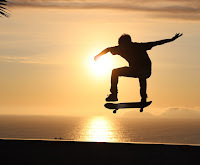 Grav Board on Kindle Vella
Grav Board on Kindle Vella #mc_embed_signup{background:#fff; clear:left; font:14px Helvetica,Arial,sans-serif; } /* Add your own Mailchimp form style overrides in your site stylesheet or in this style block. We recommend moving this block and the preceding CSS link to the HEAD of your HTML file. */ Follow by Email* indicates required Email Address * First Name Last Name (function($) {window.fnames = new Array(); window.ftypes = new Array();fnames[0]='EMAIL';ftypes[0]='email';fnames[1]='FNAME';ftypes[1]='text';fnames[2]='LNAME';ftypes[2]='text';fnames[3]='ADDRESS';ftypes[3]='address';fnames[4]='PHONE';ftypes[4]='phone';}(jQuery));var $mcj = jQuery.noConflict(true);(function($) {window.fnames = new Array(); window.ftypes = new Array();fnames[0]='EMAIL';ftypes[0]='email';fnames[1]='FNAME';ftypes[1]='text';fnames[2]='LNAME';ftypes[2]='text';fnames[3]='ADDRESS';ftypes[3]='address';fnames[4]='PHONE';ftypes[4]='phone';}(jQuery));var $mcj = jQuery.noConflict(true);
#mc_embed_signup{background:#fff; clear:left; font:14px Helvetica,Arial,sans-serif; } /* Add your own Mailchimp form style overrides in your site stylesheet or in this style block. We recommend moving this block and the preceding CSS link to the HEAD of your HTML file. */ Follow by Email* indicates required Email Address * First Name Last Name (function($) {window.fnames = new Array(); window.ftypes = new Array();fnames[0]='EMAIL';ftypes[0]='email';fnames[1]='FNAME';ftypes[1]='text';fnames[2]='LNAME';ftypes[2]='text';fnames[3]='ADDRESS';ftypes[3]='address';fnames[4]='PHONE';ftypes[4]='phone';}(jQuery));var $mcj = jQuery.noConflict(true);(function($) {window.fnames = new Array(); window.ftypes = new Array();fnames[0]='EMAIL';ftypes[0]='email';fnames[1]='FNAME';ftypes[1]='text';fnames[2]='LNAME';ftypes[2]='text';fnames[3]='ADDRESS';ftypes[3]='address';fnames[4]='PHONE';ftypes[4]='phone';}(jQuery));var $mcj = jQuery.noConflict(true);
August 16, 2021
I Decide to Publish on Kindle Vella

I don't know about other writers, but I think this is generally true--we get an idea and tuck it away for later. Later, of course, is a very fluid concept. Later can time out at a week, a month, or for me, over ten years. I don't even remember how long I've packed around the idea of how skateboards and anti-gravity technology would interact in the future. I've had the idea for a long time but haven't acted on it. And then Kindle Vella came along, and I decided to use that platform as a writing incentive for Grav Board , a serialized, episodic story about a teenager on an alien planet who likes to skateboard.
Here's the story description:
It was a brief, bloody war between the Wolfen and us--two planets destroyed along with a fleet of warships from each of our kind. Then sanity overcame aggression and a planet was chosen--Haven, a home for the diplomats and us, their kids. We were "gestures of good faith," hostages of a sort I guess. The Human and Wolfen kids were told to never interact, that we weren't old enough and smart enough to deal with First Contact issues. We nodded and said "yes," and of course, ignored them completely.
I've focused almost exclusively on blog and non-fiction writing for the last three years but have been wanting to get back into fiction. I had tried Wattpad some years back, another storytelling platform, but eventually threw in the towel. What I was writing didn't really match with the readers, I felt, but mostly in order to be successful on the platform, a lot of time had to be spent massaging the website to gain traction--more time than I was willing to spend. In my understanding, it was both a social and a publishing platform, and I wasn't either competent or inspired to spend the time at Wattpad necessary to highlight my writing.
I wanted to start writing fiction again, and this skateboarding story had always fascinated me--a blend of science fiction and growing up story, a story about friendship. The episodic nature of the platform suits my needs right now. I've written eight episodes so far, published five, and now have the opportunity to write regularly--daily--and to publish episodes to a schedule that will allow readers to expect "the next exciting installment."
It's a different experience for me because the platform (for me, at least) will lend itself to writing a rough draft, reading it over once, and then publishing it. I usually revise much more. The platform will allow me, though, to write the first draft, let it sit for a while, and then to revise and publish. I'm okay with the seat-of-your-pants style of publishing. Maybe it's the blog writing I've been doing the last few years.
What I need right now is to write fiction. I'm finding it soothing, and I think that's because I'm investing more in the process than the outcome. If writing is a journey, then right now I want to enjoy the journey. What with all the turmoil in the world, having a reality that I control completely (as much as any writer controls the process) is reassuring. It's a safe haven that I can return to again and again, a Rivendell of creativity that nurtures me in times of trouble.
Kindle Vella stories allow the first three episodes to be read for free. Then readers use tokens to gain access to following episodes, the number of tokens determined by the length of the episode. For instance, the fourth episode of Grav Board, "Hunt," is 1,459 words long and "costs" 14 tokens. Each episode has to be at least 600 words in length. Kindle provides each reader the first 200 tokens for free to get you reading.
If you're a writer, then you know that "at least 600 words" for an episode is a nice little length for a sit-me-down writing session--and we can always write more, you know! It's kind of a wild leap into thin air for me writing on this platform. Perhaps the subject of alien skateboarding is an appropriate metaphor for this time in my writing life.
If you want to read along with me as I write, please do so! After Kindle Direct Publishing informed me my first episodes were live, I went to the Kindle Vella site and tried to find Grav Board. Couldn't find it while searching categories. That's my biggest concern--the story drops into the immense ocean of platform content and disappears into the depths.
This blog article is a bit of self-marketing. If folks who read my blog articles or books are interested, go to my story, read and hopefully enjoy, and then provide a response--a review or a thumbs up. You can also share via Facebook or Twitter. Also, collect those free tokens so you can read more than the first three episodes for free. I figure that with the first three episodes being free and with the free tokens, you can read around the first twenty episodes for free. After that, I think the next two hundred tokens would cost you something like two bucks.
I've enjoyed writing the first three thousand words of this story. Getting back into the routine has been fulfilling. It's always great to have reader support, though, so follow along. It never hurts for a writer to remember that there's a reader hovering over your shoulder. It may not keep me completely aboveboard, but writers should feel free to plumb the depths for mysteries. Follow along (and, yes, there is a "follow story" button) and you'll be the first to see what treasure arises from the oceanic depths, still streaming with whatever water of creativity I can muster.
Just be sure to enjoy. Grav Board won't feature the news of the day. All science fiction fans will tell you, though, that sometimes it's the news of tomorrow that makes the joy of today. #mc_embed_signup{background:#fff; clear:left; font:14px Helvetica,Arial,sans-serif; } /* Add your own Mailchimp form style overrides in your site stylesheet or in this style block. We recommend moving this block and the preceding CSS link to the HEAD of your HTML file. */ Follow by Email* indicates required Email Address * First Name Last Name (function($) {window.fnames = new Array(); window.ftypes = new Array();fnames[0]='EMAIL';ftypes[0]='email';fnames[1]='FNAME';ftypes[1]='text';fnames[2]='LNAME';ftypes[2]='text';fnames[3]='ADDRESS';ftypes[3]='address';fnames[4]='PHONE';ftypes[4]='phone';}(jQuery));var $mcj = jQuery.noConflict(true);
#mc_embed_signup{background:#fff; clear:left; font:14px Helvetica,Arial,sans-serif; } /* Add your own Mailchimp form style overrides in your site stylesheet or in this style block. We recommend moving this block and the preceding CSS link to the HEAD of your HTML file. */ Follow by Email* indicates required Email Address * First Name Last Name (function($) {window.fnames = new Array(); window.ftypes = new Array();fnames[0]='EMAIL';ftypes[0]='email';fnames[1]='FNAME';ftypes[1]='text';fnames[2]='LNAME';ftypes[2]='text';fnames[3]='ADDRESS';ftypes[3]='address';fnames[4]='PHONE';ftypes[4]='phone';}(jQuery));var $mcj = jQuery.noConflict(true);
July 26, 2021
Is the Amazon Kindle Vella the Right Publishing Platform for Me?
 Photo @ UnsplashAs a Kindle Direct Publishing author, I've been receiving emails from KDP promoting its new publishing platform Kindle Vella. Here's a brief description they sent about this new program.
Photo @ UnsplashAs a Kindle Direct Publishing author, I've been receiving emails from KDP promoting its new publishing platform Kindle Vella. Here's a brief description they sent about this new program.
Kindle Vella is a new storytelling option from Kindle Direct Publishing to self-publish serialized stories, one short 600–5,000 word episode at a time.
To begin, we recommend publishing at least five episodes before Kindle Vella is available to readers. Then publish regularly to keep your followers coming back for more.
I researched online some regarding opinions of this new online publishing option. One article that was particularly informative for me was from the Reedsy website, "What Is Kindle Vella? And Should You Join as an Author?" The article provides an overview of Vella, describing how it works, the audience, and how authors will earn money for their writing. Bottom line, it's a lot like Wattpad.
I tried publishing on Wattpad for a while and then finally removed my writing from the platform. The reason is that serialized writing is something that you have to keep at to keep your audience. The most known authors on the platform are those who publish to their stories regularly . . . and therefore develop an audience of engaged readers who wait (hopefully with bated breath) for the next installment. The audience is mostly young readers--defined as readers who have grown up reading a lot on their phones.
I quit Wattpad because my writing routine didn't fit that pattern, but now here comes Kindle Vella, and I'm asking myself again, "Is this something I should do?" Off the top, my answer is a "no" and now I should move on. That was my perspective for about two days, and then I remembered something.
I have an idea for a young adult science fiction novel that I've been carrying around for many years. Now I have to ask myself, "Could I write the novel in a serialized form on Kindle Vella?" The Reedsy article characterizes Vella in the following manner: "Kindle Vella is Amazon’s foray into the 'serialization market,' currently dominated by established apps such as Wattpad or Radish, and with a readership consisting mostly of young readers." It sounds like Vella--or the other platforms--could provide a good incentive for me to write my tucked away story about space travel, aliens, kids (including alien kids), and skateboards that are hopped up by new technology.
I've wanted to write this novel for a long time. I think it would be fun, and having a readership to keep me encouraged and regularly writing would be great because writing is work, at least after the first ten thousand words. I find the idea intriguing, though, so I'll keep you informed.
And I don't believe that kids on hopped up skateboards saving friends and civilizations is just a story for kids. A few of us older kids enjoy reading such stories, too! #mc_embed_signup{background:#fff; clear:left; font:14px Helvetica,Arial,sans-serif; } /* Add your own Mailchimp form style overrides in your site stylesheet or in this style block. We recommend moving this block and the preceding CSS link to the HEAD of your HTML file. */ Follow by Email* indicates required Email Address * First Name Last Name (function($) {window.fnames = new Array(); window.ftypes = new Array();fnames[0]='EMAIL';ftypes[0]='email';fnames[1]='FNAME';ftypes[1]='text';fnames[2]='LNAME';ftypes[2]='text';fnames[3]='ADDRESS';ftypes[3]='address';fnames[4]='PHONE';ftypes[4]='phone';}(jQuery));var $mcj = jQuery.noConflict(true);
#mc_embed_signup{background:#fff; clear:left; font:14px Helvetica,Arial,sans-serif; } /* Add your own Mailchimp form style overrides in your site stylesheet or in this style block. We recommend moving this block and the preceding CSS link to the HEAD of your HTML file. */ Follow by Email* indicates required Email Address * First Name Last Name (function($) {window.fnames = new Array(); window.ftypes = new Array();fnames[0]='EMAIL';ftypes[0]='email';fnames[1]='FNAME';ftypes[1]='text';fnames[2]='LNAME';ftypes[2]='text';fnames[3]='ADDRESS';ftypes[3]='address';fnames[4]='PHONE';ftypes[4]='phone';}(jQuery));var $mcj = jQuery.noConflict(true);
July 8, 2021
I Fulfill a Request for a Signed Copy of My New Book: RTTC Bears in the Wild
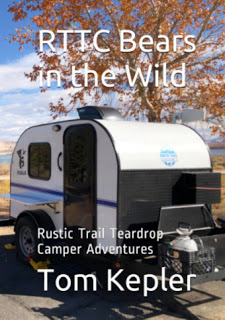 RTTC Bears in the WildI can see why authors participate in book signing events. Not only does it promote the book, but such an event also is good for the author's sense of accomplishment. Readers show up and not only buy a book but also want it signed by the author. Of course, this is all true only if readers show up! I've read accounts of the opposite happening; when no one shows up to a book signing, then we must look deep into those waters of personal motivation.
RTTC Bears in the WildI can see why authors participate in book signing events. Not only does it promote the book, but such an event also is good for the author's sense of accomplishment. Readers show up and not only buy a book but also want it signed by the author. Of course, this is all true only if readers show up! I've read accounts of the opposite happening; when no one shows up to a book signing, then we must look deep into those waters of personal motivation.Recently, I was asked through Facebook Messenger for a signed copy of RTTC Bears in the Wild. The reader had given her copy of the book away to a friend and contacted me asking for a signed copy. It had been a long time since I'd done this, and since I knew her from online, I told her I'd mail her a book and then contact her about how much it would cost.
The cost of printing RTTC Bears in the Wild is about two and a half times more than a book of similar pages but without the color photographs. When determining the cost of the little book, I had to factor the increased printing cost, of course. Also POD (Print on Demand) costs are higher than traditional mass printing. I like the POD publishing model, though, for a several reasons. One is that there are no upfront printing costs that the publisher and author must then recoup. Another is that there are no storage issues for the books--500 or 5,000 books take up quite a bit of space, and then there are also the issues of protection of the book, too, to ensure that water, humidity, and insects and rodents don't damage the book. Finally, there is the environmental plus with POD publishing that only those books purchased are printed. Trees are cut down to print books that are never read; energy is needlessly spent for printing that isn't needed. All these issues morph, of course, when discussing ebooks. The environmental discussion still deals with energy consumption, though.
I have a downstairs cupboard full of copies of my books--mostly my first three books. I've learned my lesson, though, and no longer buy a hundred copies of a new book. Ten copies will do, and I can always order more. I don't do promotional book signings, especially in my home town. I guess I feel that I just want to connect to readers online and not have to put my local friends through the decision-making process of "Oh, should we go to Tom's book signing? Do we have to buy a book? I don't want to hurt his feelings by not showing up." I have placed my books in a local book store, though. That was easy and seemed reasonable. I've also considered selling my books at the local Farmers' Market. I could set my table up next to a friend and spend a fun Saturday morning maybe selling a book but certainly chatting with folks. And I could buy a week's worth of zuchini--or maybe manage a swap!
It turns out that it's less expensive to buy a book from me personally than buying it online from Amazon. When a reader buys a copy of one of my books from Amazon, I receive sixty percent of the sale price. The rest goes to Kindle Direct Publishing for printing. KDP describes it as follows: "KDP offers a fixed 60% royalty rate on paperbacks sold on Amazon marketplaces where KDP supports paperback distribution. Your royalty is 60% of your list price. We then subtract printing costs, which depend on page count, ink type, and the Amazon marketplace your paperback was ordered from." This sounds pretty good--six dollars in royalties for a small book using black ink. However, those distribution marketplace costs are taken from the royalties, so in truth a ten-dollar book would maybe get an author two dollars for royalties. Here is a link from Martin Publishing Services (click here) if you're interested in learning more.
Another reason that it costs less to buy a book from me, rather than from Amazon (for the three books I've published exclusively via KDP) is that I do the packaging and mailing. If I were to charge for the hour it takes me to package the book and then take it to the post office, then . . . well, I really can't even consider that if I want to consider economics. It is fulfilling to mail a book off, though. There's a personal connection established by writing in the book and then mailing it off. If I were doing this all day long in order to make my living money, then I'd have to raise my prices. Occasionally mailing a signed copy to a reader? That's a gesture of respect.
Henry David Thoreau once commented on his publishing of Walden, something along these lines--"I have a library of one thousand books, of which nine hundred are the book I wrote." I've managed to not "save money" by privately printing a large number of books, where each book printed would indeed cost less than POD publishing. However, I have cut my upfront costs to almost nothing and also don't have to stare at a roomful of books and wonder, "What am I going to do with all those darn books?" The good news is that rather than worrying about how I can sell more copies of my recent camping book--I'm just going camping!
July 1, 2021
Creating and Publishing a Book on Kindle Direct Publishing (KDP) Using a Chromebook and Google Drive
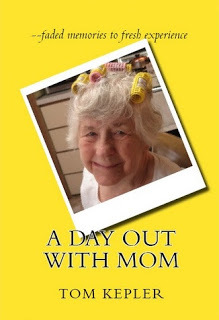 A Day Out with MomThat's a pretty long title for this article, especially since this article isn't going to be a long and detail-filled exposition of step-by-step how to put together a book using the online-centered Chromebook and Google Drive platforms. The truth is that it's not that difficult to independently publish your own book using Kindle Direct Publishing's program. I've used the KDP platform to publish three small books (around one hundred pages) that have been based on blog articles I've written. My last book, recently published, is the first one, though, that I've put together using Google Drive's online word processing rather than Microsoft word processing and a fully independent laptop. The bottom line is that working online with a Chromebook was a bit slower at times, that the Google Doc word processing program was a bit more limited than Word, but that once I realized the differences, I was pretty much able to do whatever I wanted to create the book. Here are the three books I've published through Amazon's KDP, available both as paperbacks and as ebooks:
RTTC Bears in the Wild
(2021)
A Day Out with Mom
(2014)
I Write: Being and Writing
(2012)KDP allows an author to sign up and then begin creating a book, walking the author through the steps of "Creating a New Title":Book Content: You can upload a manuscript, or use our free creation tools to create children's books, educational content, comics, and manga. Get started with Kindle content creation tools.Book Cover: You can use our online Cover Creator, or upload a cover of your own. Creating a great cover.Description, Keywords and Categories: Tell readers about your book and help them find it on Amazon.ISBN: Get a free ISBN to publish your paperback. Kindle eBooks don't need one. More about ISBNs.
A Day Out with MomThat's a pretty long title for this article, especially since this article isn't going to be a long and detail-filled exposition of step-by-step how to put together a book using the online-centered Chromebook and Google Drive platforms. The truth is that it's not that difficult to independently publish your own book using Kindle Direct Publishing's program. I've used the KDP platform to publish three small books (around one hundred pages) that have been based on blog articles I've written. My last book, recently published, is the first one, though, that I've put together using Google Drive's online word processing rather than Microsoft word processing and a fully independent laptop. The bottom line is that working online with a Chromebook was a bit slower at times, that the Google Doc word processing program was a bit more limited than Word, but that once I realized the differences, I was pretty much able to do whatever I wanted to create the book. Here are the three books I've published through Amazon's KDP, available both as paperbacks and as ebooks:
RTTC Bears in the Wild
(2021)
A Day Out with Mom
(2014)
I Write: Being and Writing
(2012)KDP allows an author to sign up and then begin creating a book, walking the author through the steps of "Creating a New Title":Book Content: You can upload a manuscript, or use our free creation tools to create children's books, educational content, comics, and manga. Get started with Kindle content creation tools.Book Cover: You can use our online Cover Creator, or upload a cover of your own. Creating a great cover.Description, Keywords and Categories: Tell readers about your book and help them find it on Amazon.ISBN: Get a free ISBN to publish your paperback. Kindle eBooks don't need one. More about ISBNs.
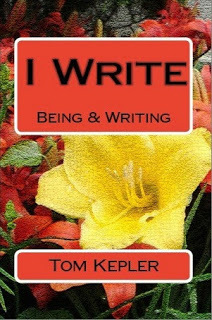 I Write: Being & WritingFor each step, Amazon KDP provides guidance, and there are also usually online blogs and YouTube videos that provide insights. What I've found about Chromebooks, which don't have the memory capacity of traditional computers because information is saved online, and what I've found out about working on Google Drive's doc platform, is that there are a few speed and capabilities limitations. However, for a traditional book layout, these boundaries are more occasional nuisances than deal breakers.
I Write: Being & WritingFor each step, Amazon KDP provides guidance, and there are also usually online blogs and YouTube videos that provide insights. What I've found about Chromebooks, which don't have the memory capacity of traditional computers because information is saved online, and what I've found out about working on Google Drive's doc platform, is that there are a few speed and capabilities limitations. However, for a traditional book layout, these boundaries are more occasional nuisances than deal breakers. I've put together eight books since 2010 (see my Amazon author's page), using Adobe, Microsoft, and Google Doc word processing programs. The first book, a poetry book, was compiled using Microsoft Word, the next two used Adobe's InDesign, and the last have used KDP with Word or Google Doc templates. I had a friend who helped me a lot with the first three books, and we also designed the book covers using Adobe Photo Shop. For the later books, I used KDP's book design templates.
Here are some of the nuisances and limitations I've discovered using KDP and Google Docs on a Chromebook.The KDP downloaded templates have a set number of chapters when downloaded. Because of my limited word processing and designing expertise, I found the process of working with the sections, rows, and columns to be a challenge, especially since I only put together a book every few years. I did manage by fiddling around to learn how to widen certain cells or add more rows in the table of contents section. I learned how to add more chapters to the book and table of contents. If I knew more, I probably could have been more efficient, though.Some of what I learned through my experience with Word had to be massaged to understand for Google Docs. For instance, adding anchors for ebook navigation in Word (moving from the table of contents to the chapter and back to the TOC) was not exactly the same for Google Docs. "Bookmarks" is the Docs designation for anchors, and the possibilities for use seem to be limited in Docs. I say "seem" because it wasn't always clear. I'd read an article online of how to set up an ebook's table of contents for the Amazon Kindle platform using Docs, and then some of the directions from the article met up with the Docs platform just not having the "go to" or "click" steps available. As my book grew in length--as I inserted chapters and photos--saving the program grew a little longer. I had moments of panic when I received a message from the Kindle draft viewing function saying that there was an error in saving. What! Had I lost the entire manuscript? What I realized after a time of panic was that the movement of the manuscript from Google Drive to Kindle might take a bit and to not jump right from compiling the book on Drive to checking out what the book will look like on the preview section. The process was not instantaneous. That scare did lead me, though, to regularly making copies of the publishing draft and saving them under a new name, such as "Bear March 25," which provided the assurance that if all my compiling work did get lost or corrupted in the ether, that I'd have a copy of what I'd created.These few insights leads me to the need to reiterate that my last three books have been collections of blog articles that I've compiled into books, listed earlier in this article. Creating the book wasn't just copying and pasting the articles into the book template, though. I mean, well, it was that, but a book is different than a blog; book chapters are different than blog articles. Time flows differently in a book than in a blog. Words like "here," "now," and "today" don't play out the same in books as in blogs. Therefore, the final manuscript for these books was significantly different than all the blog articles put together. The books are unique documents, and losing a manuscript because saving in the cloud didn't work would be a real downer.
My blog articles were in a very real way just drafts of an upcoming book that I've shared with readers. For my first blog-to-book adventure--I Write: Being and Writing--I didn't even have the idea of putting the articles together into a book until while talking to a friend about a series of articles I was writing he said, "Hey, you know, you could put those together into a book." That may seem pretty obvious, but it was a revelation to me at the time. The concept isn't new, that's for sure. During the 1800s, Dickens and others first serialized their novels for periodicals prior to publishing them as books.
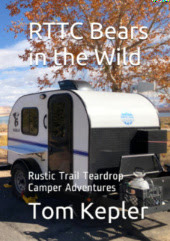 RTTC Bears in the WildMy final thoughts on using laptops that word process primarily from online platforms--and then coupling that with online independent publishing platforms--is that regular creation of backup files of the manuscript (even if backed up online) is always a good idea. It will provide you with a sense of security. A second point is that there may be time lags sometimes, that you can't just jump from one step to another quickly. Be patient. And finally, the Google Doc word processing program may have some limitations that can probably be worked around but which might cause some frustration or even necessitate some adaptation.
RTTC Bears in the WildMy final thoughts on using laptops that word process primarily from online platforms--and then coupling that with online independent publishing platforms--is that regular creation of backup files of the manuscript (even if backed up online) is always a good idea. It will provide you with a sense of security. A second point is that there may be time lags sometimes, that you can't just jump from one step to another quickly. Be patient. And finally, the Google Doc word processing program may have some limitations that can probably be worked around but which might cause some frustration or even necessitate some adaptation. These are just my experiences, but most folks are like me, not wizards at all the ins and outs of whatever word process and publishing platforms are being utilized. It's like fixing something in our home. You fix or replace something, and then ten years later you have to do it again. "Now how did I do that?" you think, and then you have to go back and learn all over, at the same time realizing that in ten years things have changed. Oh, well! I've managed to produce a nice little book, RTTC Bears in the Wild , which I think provides some good reading and good color photos this last time around. It was a great experience to research this little camping book, to write the blog articles, and then to put everything together and make available both as a paperback and an ebook. Although not the only game in town (KDP only publishes on Amazon), I've found my Chromebook, Google Doc, and KDP combination to work fine for me. If you want to read the book, it's readily available, and I call that a successful venture into independent publishing.
 #mc_embed_signup{background:#fff; clear:left; font:14px Helvetica,Arial,sans-serif; } /* Add your own Mailchimp form style overrides in your site stylesheet or in this style block. We recommend moving this block and the preceding CSS link to the HEAD of your HTML file. */ Follow by Email* indicates required Email Address * First Name Last Name (function($) {window.fnames = new Array(); window.ftypes = new Array();fnames[0]='EMAIL';ftypes[0]='email';fnames[1]='FNAME';ftypes[1]='text';fnames[2]='LNAME';ftypes[2]='text';fnames[3]='ADDRESS';ftypes[3]='address';fnames[4]='PHONE';ftypes[4]='phone';}(jQuery));var $mcj = jQuery.noConflict(true);
#mc_embed_signup{background:#fff; clear:left; font:14px Helvetica,Arial,sans-serif; } /* Add your own Mailchimp form style overrides in your site stylesheet or in this style block. We recommend moving this block and the preceding CSS link to the HEAD of your HTML file. */ Follow by Email* indicates required Email Address * First Name Last Name (function($) {window.fnames = new Array(); window.ftypes = new Array();fnames[0]='EMAIL';ftypes[0]='email';fnames[1]='FNAME';ftypes[1]='text';fnames[2]='LNAME';ftypes[2]='text';fnames[3]='ADDRESS';ftypes[3]='address';fnames[4]='PHONE';ftypes[4]='phone';}(jQuery));var $mcj = jQuery.noConflict(true);
June 20, 2021
A Blended, Extended Family Father's Day
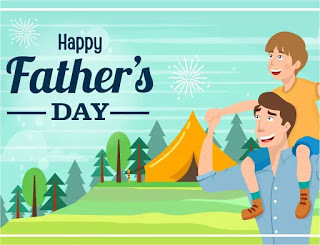
It's funny how things change. When I first moved to Iowa in 1984, it was just my first wife and me. My parents, brother and sister, and all my relatives were in California. Most of my wife's parents were in Washington state. Now, thirty-seven years later, my first wife has passed, her parents, my parents and brother and sister, and all my aunts and uncles except one.
This is not a Father's Day lament, though, about my isolation and old-age angst. I am very fortunate. I did remarry, which was actually a wonderfully funny surprise to us both . . . but that's another story. Over the last sixteen years, there were many comings and goings of our children, my wife Sandy's son and daughter and my first wife Barbara and my son. At times we were alone with our children scattered across half the continent, but on this Father's Day I can say that happily that is not the case.
All our children are now here in town with us, having settled here--along with the children of Sandy's daughter and those of my son and his wife. Also with Sandy's son and his girlfriend, that makes us a total of thirteen: Grandpa and Grandma (Sandy and me), three children and their partners, and five grandchildren, including my son's blended family. On this Father's Day, I am definitely not living in isolation, sitting on my porch and watching other people pass by, walking or driving or bicycling, living their lives while I increasingly dwelling in the past.
I am sitting in my living room at dawn right now, the window open for a while before the day heats up, and just from where I'm sitting I can see the dynamism of my family interactions. Over below the TV table is a galvanized tub filled with odds and ends of toys we've brought over from Sandy's daughter's place. Sitting kind of in the middle of the room is a box full of food staples that we had too much of and Sandy's son is coming to pick the food up. Beside the box of food is a burlap carrying bag that my wife uses for swimming necessaries when she heads up to the city's local lake. Along with towels, she'll stuff it with juice boxes and snacks for the grandkids.
To my right next to the sofa is a stack of books I researched on our local public library's website and then checked out for Sandy. You see, I'm heading out tomorrow to a local campground for a week in our new Airstream Basecamp travel trailer, and I wanted to make sure that Sandy has plenty of reading material on hand. We're planning on Sandy coming to camp with me next weekend, if not sooner, depending on what her business requires. Speaking of reading, I'm on my computer and realize I also have regular communication with my first wife Barbara's family in Washington. It's a big, connected world.
I am surrounded by family, planted deeply in the rich soil of family (even if sometimes we wonder if we're planted a little too deeply), and am as busy and connected as I can possibly be. This evening when it cools, my son and Sandy's daughter's husband are coming to fix a leak on the roof. When I'm gone camping, my son will keep the garden watered. Later this summer I will buy a big load of firewood, and I'm pretty sure and hope to god "the boys" will come over and help me stack it.
On this Father's Day, I wish to celebrate the idea that "families are made in many ways." My mother was adopted; my son is adopted. Right now Sandy and I are the paterfamilias and materfamilias of our extended, blended family that includes thirteen wonderful souls. We all have many opportunities to create family, and it doesn't even have to be through marriage or partnership. It has to do with reaching out and giving and receiving. It has to do with including, not excluding--reaching out rather than pushing away. I am lucky, I am fortunate. I am so far away from "lonely" that I'm looking forward to a little quiet camping time. It is summer, though, so Sandy and I won't be at all surprised if our little quiet camping getaway is interrupted by the arrival of at least one car full of kids and grandkids. And that will be just fine. Happy Father's Day, Tom. #mc_embed_signup{background:#fff; clear:left; font:14px Helvetica,Arial,sans-serif; } /* Add your own Mailchimp form style overrides in your site stylesheet or in this style block. We recommend moving this block and the preceding CSS link to the HEAD of your HTML file. */ Follow by Email* indicates required Email Address * First Name Last Name (function($) {window.fnames = new Array(); window.ftypes = new Array();fnames[0]='EMAIL';ftypes[0]='email';fnames[1]='FNAME';ftypes[1]='text';fnames[2]='LNAME';ftypes[2]='text';fnames[3]='ADDRESS';ftypes[3]='address';fnames[4]='PHONE';ftypes[4]='phone';}(jQuery));var $mcj = jQuery.noConflict(true);
#mc_embed_signup{background:#fff; clear:left; font:14px Helvetica,Arial,sans-serif; } /* Add your own Mailchimp form style overrides in your site stylesheet or in this style block. We recommend moving this block and the preceding CSS link to the HEAD of your HTML file. */ Follow by Email* indicates required Email Address * First Name Last Name (function($) {window.fnames = new Array(); window.ftypes = new Array();fnames[0]='EMAIL';ftypes[0]='email';fnames[1]='FNAME';ftypes[1]='text';fnames[2]='LNAME';ftypes[2]='text';fnames[3]='ADDRESS';ftypes[3]='address';fnames[4]='PHONE';ftypes[4]='phone';}(jQuery));var $mcj = jQuery.noConflict(true);
June 14, 2021
Giving Books to My Local Public Library
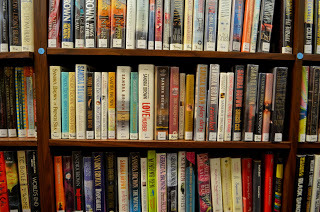 When our local public library closed because of the pandemic, that didn't stop my wife and me from reading. It did affect how we acquired our books, though. I learned how to browse the public library's book list from the online catalog and, thankfully, was able to check out books via their curbside delivery program.
When our local public library closed because of the pandemic, that didn't stop my wife and me from reading. It did affect how we acquired our books, though. I learned how to browse the public library's book list from the online catalog and, thankfully, was able to check out books via their curbside delivery program. I discussed my online browsing and curbside pick-up in an earlier post: "My Local Public Library Has Only Curbside Service--How I Learned to Browse Online." Learning how to browse for library books online has been a fun adventure, especially when browsing for books my wife might like to read. I've discovered some new sub-genres (such as the "cozy" mystery) and some new authors, in addition to forming what really amounts to my wife and my very own husband/wife book club.
Often, though, an author we discover online has only one or two books from a series that our library has on the shelves. We've had to purchase books, used or new, to fill in a series we are reading. As an example, the author Mary Alice Monroe has written a trilogy set in the Carolinas called the "Lowcountry Summer" series. Our library had the first two books in the series but not the third, which we bought. It also had one book from Monroe's "Beach House" series, so we bought the other books in the series, plus some of Monroe's standalone novels.
Another author whom we've bought quite a few books from is Anna Lee Huber. Huber has written nine books in one series and four in another, and our library had the last book from each series. After researching Huber, my wife and I decided to buy the first book in each series to see how much we liked the writing. We ended up buying all the books in each series--except the last, of course, since our LPL had those two on its shelves.
The question arises, though, of what to do with all those books we've bought, especially since they are "just one time" reads. And the answer, of course, is to donate them to the library!
When I mentioned to the librarian that I had some books my wife and I had bought that filled in missing books from some series that the library owned, the librarian's response was somewhat unexpected, even though on second thought it made perfect sense. She said that not all donated books make the shelves. I knew this, since the library holds regular book sales and even has a section of the library that holds used books for sale.
The librarian also said that even if a book donated completes a trilogy, as my "Lowcountry Summer" example mentioned earlier, the book still might not make it to the shelves. It seems that it would; after all, why not complete the trilogy? What the librarian explained was that if the two books in the trilogy had only been checked out once--say in the last five years--and that once was by me, then rather than completing the trilogy, the two books on the shelves might be discarded and included, along with my donation, to a regular library book sale.
It doesn't really matter to me, though. Either way I am supporting the library, either by improving the quality of the books to loan or by adding to the library's coffers when they sell a book I donated. That makes me happy. As far as I'm concerned, free public libraries are among the most nurturing, positive institutions that were ever imagined. Read on and prosper!
 #mc_embed_signup{background:#fff; clear:left; font:14px Helvetica,Arial,sans-serif; } /* Add your own Mailchimp form style overrides in your site stylesheet or in this style block. We recommend moving this block and the preceding CSS link to the HEAD of your HTML file. */ #mc_embed_signup{background:#fff; clear:left; font:14px Helvetica,Arial,sans-serif; } /* Add your own Mailchimp form style overrides in your site stylesheet or in this style block. We recommend moving this block and the preceding CSS link to the HEAD of your HTML file. */ Follow by Email* indicates required Email Address * First Name Last Name (function($) {window.fnames = new Array(); window.ftypes = new Array();fnames[0]='EMAIL';ftypes[0]='email';fnames[1]='FNAME';ftypes[1]='text';fnames[2]='LNAME';ftypes[2]='text';fnames[3]='ADDRESS';ftypes[3]='address';fnames[4]='PHONE';ftypes[4]='phone';}(jQuery));var $mcj = jQuery.noConflict(true); (function($) {window.fnames = new Array(); window.ftypes = new Array();fnames[0]='EMAIL';ftypes[0]='email';fnames[1]='FNAME';ftypes[1]='text';fnames[2]='LNAME';ftypes[2]='text';fnames[3]='ADDRESS';ftypes[3]='address';fnames[4]='PHONE';ftypes[4]='phone';fnames[5]='BIRTHDAY';ftypes[5]='birthday';}(jQuery));var $mcj = jQuery.noConflict(true);
#mc_embed_signup{background:#fff; clear:left; font:14px Helvetica,Arial,sans-serif; } /* Add your own Mailchimp form style overrides in your site stylesheet or in this style block. We recommend moving this block and the preceding CSS link to the HEAD of your HTML file. */ #mc_embed_signup{background:#fff; clear:left; font:14px Helvetica,Arial,sans-serif; } /* Add your own Mailchimp form style overrides in your site stylesheet or in this style block. We recommend moving this block and the preceding CSS link to the HEAD of your HTML file. */ Follow by Email* indicates required Email Address * First Name Last Name (function($) {window.fnames = new Array(); window.ftypes = new Array();fnames[0]='EMAIL';ftypes[0]='email';fnames[1]='FNAME';ftypes[1]='text';fnames[2]='LNAME';ftypes[2]='text';fnames[3]='ADDRESS';ftypes[3]='address';fnames[4]='PHONE';ftypes[4]='phone';}(jQuery));var $mcj = jQuery.noConflict(true); (function($) {window.fnames = new Array(); window.ftypes = new Array();fnames[0]='EMAIL';ftypes[0]='email';fnames[1]='FNAME';ftypes[1]='text';fnames[2]='LNAME';ftypes[2]='text';fnames[3]='ADDRESS';ftypes[3]='address';fnames[4]='PHONE';ftypes[4]='phone';fnames[5]='BIRTHDAY';ftypes[5]='birthday';}(jQuery));var $mcj = jQuery.noConflict(true);



